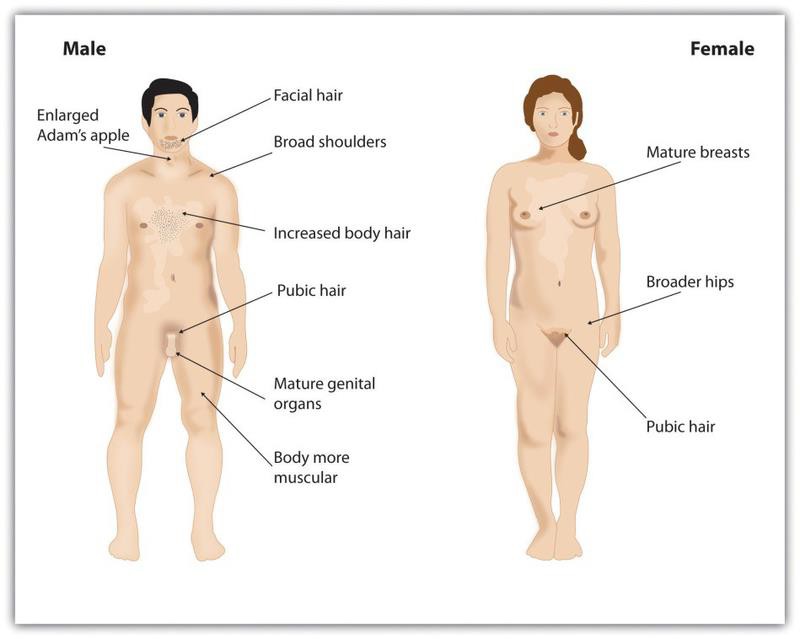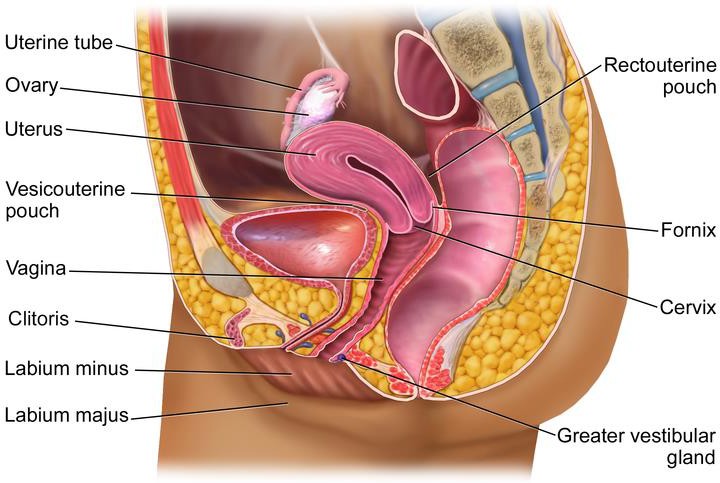114 Physical Changes in Adolescence
The physical growth and the changes of puberty mark the onset of adolescence (Lerner & Steinberg, 2009). For both boys and girls, these changes include a growth spurt in height, growth of pubic and underarm hair, and skin changes (e.g., pimples). Hormones drive these pubescent changes, particularly the increase in testosterone for biological males and estrogen for biological females.[1] Puberty is a developmental period in which hormonal changes cause rapid physical alterations in the body, culminating in sexual maturity. Although the timing varies to some degree across cultures, the average age range for reaching puberty is between 9 and 14 years for biological females and between 10 and 17 years for biological males (Marshall & Tanner, 1986). This period of physical development of the adolescent age 9-13 is divided into two phases.[2]

The first phase of puberty begins when the pituitary gland begins to stimulate the production of the male sex hormone testosterone in biological males and the female sex hormones estrogen and progesterone in biological females. The release of these sex hormones triggers the development of the primary sex characteristics, the sex organs concerned with reproduction. It also involves height increases from 20 to 25 percent. Puberty is second to the prenatal period in terms of rapid growth as the long bones stretch to their final, adult size. Biological females grow 2–8 inches (5–20 centimeters) taller, while biological males grow 4–12 inches (10–30 centimeters) taller.
Secondary sexual characteristics are visible physical changes not directly linked to reproduction but signal sexual maturity. The growth spurt for biological females usually occurs earlier than that for biological males, with some males continuing to grow into their 20s. For males this includes broader shoulders, an enlarged Adam’s apple, and a lower voice as the larynx grows. Biological males typically begin to grow facial hair between ages 14 and 16, which becomes coarser and darker, and hair growth occurs in the pubic area, under the arms, and on the face.
For biological females the enlargement of breasts is usually the first sign of puberty and, on average, occurs between ages 10 and 12 (Marshall & Tanner, 1986). Their hips broaden and pubic and underarm hair develops and becomes darker and coarser. Adolescents regardless of gender experience a rapid growth spurt during this stage. Adolescents may begin shaving during this time period as well as showing signs of acne on their faces and bodies.

Acne is an unpleasant consequence of the hormonal changes in puberty. Acne is defined as pimples on the skin due to overactive sebaceous (oil-producing) glands (Dolgin, 2011). These glands develop at a greater speed than the skin ducts that discharge the oil. Consequently, the ducts can become blocked with dead skin and acne will develop. According to the University of California at Los Angeles Medical Center (2000), approximately 85% of adolescents develop acne, and biological males develop acne more than biological females because of greater levels of testosterone in their systems (Dolgin, 2011). Hormones that are also responsible for sexual development can also wreak havoc on the teenage skin.[3]
A major milestone in puberty for biological females is menarche, the first menstrual period, typically experienced at around 12 or 13 years of age (Anderson, Dannal, & Must, 2003). The age of menarche varies substantially and is determined by genetics, as well as by diet and lifestyle, since a certain amount of body fat is needed to attain menarche. Biological females who are very slim, who engage in strenuous athletic activities, or who are malnourished may begin to menstruate later. Even after menstruation begins, individuals whose level of body fat drops below the critical level may stop having their periods. The sequence of events for puberty is more predictable than the age at which they occur. Some biological females may begin to grow pubic hair at age 10 but not attain menarche until age 15.[4]
Male Anatomy
Biological males have both internal and external genitalia that are responsible for procreation and sexual intercourse. Biological males produce their sperm on a cycle, and unlike the biological female’s ovulation cycle, the male sperm production cycle is constantly producing millions of sperm daily. The male sex organs are the penis and the testicles, the latter of which produce semen and sperm. The semen and sperm, as a result of sexual intercourse, can fertilize an ovum in the female’s body; the fertilized ovum (zygote) develops into a fetus, which is later born as a child.

Video reviews male reproductive organs.
Female Anatomy
External genitalia for biological females is collectively known as the vulva, which includes the mons veneris, labia majora, labia minora, clitoris, vaginal opening, and urethral opening. Female internal reproductive organs consist of the vagina, uterus, fallopian tubes, and ovaries. The uterus hosts the developing fetus, produces vaginal and uterine secretions, and passes the male’s sperm through to the fallopian tubes while the ovaries release the eggs. A biological female is born with all eggs already produced. The vagina is attached to the uterus through the cervix, while the uterus is attached to the ovaries via the fallopian tubes. Biological females have a monthly reproductive cycle; at certain intervals the ovaries release an egg, which passes through the fallopian tube into the uterus. If, in this transit, it meets with sperm, the sperm might penetrate and merge with the egg, fertilizing it. If not fertilized, the egg and the tissue that was lining the uterus is flushed out of the system through menstruation (around every 28 days).

Video reviews female reproductive organs.
Effects of Puberty on Development
The age of puberty is getting younger for children throughout the world. A century ago the average age of an individual’s first period in the United States and Europe was 16, while today it is around 13. Because there is no clear marker of puberty for biological males, it is harder to determine if they are maturing earlier, too. In addition to better nutrition, less positive reasons associated with early puberty for biological females include increased stress, obesity, and endocrine disrupting.
Because rates of physical development vary so widely among teenagers, puberty can be a source of pride or embarrassment. Individuals who develop more slowly than their peers may feel self-conscious about their lack of physical development; some research has found that negative feelings are particularly a problem for late maturing biological males, who are at a higher risk for depression and conflict with parents (Graber et al., 1997) and more likely to be bullied (Pollack & Shuster, 2000). Additionally, problems are more likely to occur when the child is among the first in his or her peer group to develop. Because the preadolescent time is one of not wanting to appear different, early developing children stand out among their peer group and gravitate toward those who are older (Weir, 2016).
Early maturing biological males tend to be physically stronger, taller, and more athletic than their later maturing peers; this can contribute to differences in popularity among peers, which can in turn influence the teenager’s confidence. Some studies show that males who mature earlier tend to be more popular and independent but are also at a greater risk for substance abuse and early sexual activity (Flannery, Rowe, & Gulley, 1993; Kaltiala-Heino, Rimpela, Rissanen, & Rantanen, 2001).
Early maturing biological females may face increased teasing and sexual harassment related to their developing bodies, which can contribute to self-consciousness and place them at a higher risk for anxiety, depression, substance abuse, and eating disorders (Ge, Conger, & Elder, 2001; Graber, Lewinsohn, Seeley, & Brooks-Gunn, 1997; Striegel-Moore & Cachelin, 1999).[5]
Video reviews pubertal changes across multiple areas of physical development for individuals who’s biological sex is female.
- Adolescent Development by Jennifer Lansford is licensed under CC BY-NC-SA 4.0 ↵
- Adolescence: Developing Independence and Identity by Charles Stangor is licensed under CC BY-NC-SA 3.0; ↵
- Lifespan Development: A Psychological Perspective by Martha Lally and Suzanne Valentine-French is licensed under CC BY-NC-SA 3.0; ↵
- Adolescence: Developing Independence and Identity by Charles Stangor is licensed under CC BY-NC-SA 3.0; ↵
- Adolescence Physical Growth by Boundless.com is licensed under CC BY-SA 4.0; Lifespan Development: A Psychological Perspective by Martha Lally and Suzanne Valentine-French is licensed under CC BY-NC-SA 3.0 (all sections modified by Courtney Boise) ↵

